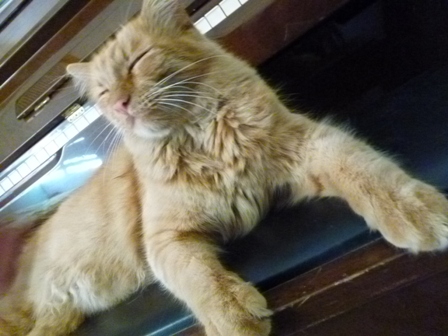Cats’ Purr: What are the Reasons?
Cats’ Purr: What are the Reasons?
The kittens do not need any training to learn to purr. They use it from their very first breath. They are born with it. The kitten’s purr is often considered as the way to say to his mother “I’m here and everything is fine”. Many cat owners, naturally, think that the cat purring is the sign of contentment and happiness. From their experience with cats, they associate purring with the soothing, calming and relaxing effect the purr has on them. We all heard how beneficial is the cats purring on the human health, especially on reducing stress or diminish the illnesses closely connected with stress. This is true, indeed, but it is the only one reason, and what about the others? Why do the cats really purr? Let us see what has been said in Scientific American’s article “Why Do Cats Purr?”on this topic.
Cats’ Purr: What are the Reasons:
“… Cats often purr while under duress, such as during a visit to the veterinarian or when recovering from injury. Thus, not all purring cats appear to be content or pleased with their current circumstances. This riddle has lead researchers to investigate how cats purr, which is also still under debate.
Scientists have demonstrated that cats produce the purr through intermittent signaling of the laryngeal and diaphragmatic muscles. Cats purr during both inhalation and exhalation with a consistent pattern and frequency between 25 and 150 Hertz. Various investigators have shown that sound frequencies in this range can improve bone density and promote healing.
This association between the frequencies of cats’ purrs and improved healing of bones and muscles may provide help for some humans. Bone density loss and muscle atrophy is a serious concern for astronauts during extended periods at zero gravity. Their musculo-skeletal systems do not experience the normal stresses of physical activity, including routine standing or sitting, which requires strength for posture control.
Because cats have adapted to conserve energy via long periods of rest and sleep, it is possible that purring is a low energy mechanism that stimulates muscles and bones without a lot of energy. The durability of the cat has facilitated the notion that cats have “nine lives” and a common veterinary legend holds that cats are able to reassemble their bones when placed in the same room with all their parts. Purring may provide a basis for this feline mythology. The domestication and breeding of fancy cats occurred relatively recently compared to other pets and domesticated species, thus cats do not display as many muscle and bone abnormalities as their more strongly selected carnivore relative, the domestic dog. Perhaps cats’ purring helps alleviate the dysplasia or osteoporotic conditions that are more common in their caned cousins. Although it is tempting to state that cats purr because they are happy, it is more plausible that cat purring is a means of communication and a potential source of self-healing.”
Another scientific study has been performed in 2009 by Dr Karen McComb, at the University of Sussex. In the article “Cats ‘Exploit’ Humans by Purring” has been said:
“… Cats use a “soliciting purr” to overpower their owners and garner attention and food.
Unlike regular purring, this sound incorporates a “cry”, with a similar frequency to a human baby’s.
The team said cats have “tapped into” a human bias – producing a sound that humans find very difficult to ignore.
Dr Karen McComb, the lead author of the study that was published in the journal Current Biology, said the research was inspired by her own cat, Pepo.
“He would wake me up in the morning with this insistent purr that was really rather annoying,” Dr McComb told BBC News.”
The article continues with the following:
“Previous studies have found similarities between a domestic cat’s cry and the cry of a human baby – a sound that humans are highly sensitive to.
Dr McComb said that the cry occurs at a low level in cats’ normal purring. “But we think that (they) learn to dramatically exaggerate it when it proves effective in generating a response from humans.”
She added that the trait seemed to most often develop in cats that have a one-on-one relationship with their owners. “
Maybe the best comparison has been given by Kelly Morgan, DVM, clinical instructor at the Chicago Center for Veterinary medicine of the University of Illinois. She compared the cat’s purr with the human’s smile. Is it true that we are smiling only when we are happy? We are smiling not only when we are cheerful or satisfied, but also when we try to hide that we are under the stress, nervous or frightened. If we perceive the purring of the cat as the way of communication, then we can ask ourselves: what our cat wants to tell us? Maybe the message is: “Mom, I’m here and I’m ok”, or “Calm down, everything is fine”. Maybe it is useful to ask the questions – is the cat comforting us or who is the cat really comforting? There are different messages that can emerge from purring and the next time when our cat purr, we may ask ourselves: what is the message now? Or maybe just relax and enjoy in this cutest trait.










